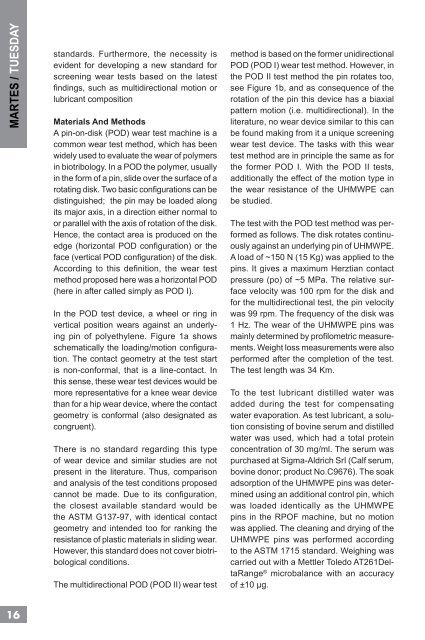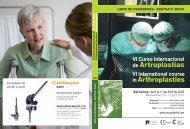cadera / hip - Active Congress.......
cadera / hip - Active Congress.......
cadera / hip - Active Congress.......
You also want an ePaper? Increase the reach of your titles
YUMPU automatically turns print PDFs into web optimized ePapers that Google loves.
MARTES / TUESDAY<br />
16<br />
standards. Furthermore, the necessity is<br />
evident for developing a new standard for<br />
screening wear tests based on the latest<br />
fi ndings, such as multidirectional motion or<br />
lubricant composition<br />
Materials And Methods<br />
A pin-on-disk (POD) wear test machine is a<br />
common wear test method, which has been<br />
widely used to evaluate the wear of polymers<br />
in biotribology. In a POD the polymer, usually<br />
in the form of a pin, slide over the surface of a<br />
rotating disk. Two basic confi gurations can be<br />
distinguished; the pin may be loaded along<br />
its major axis, in a direction either normal to<br />
or parallel with the axis of rotation of the disk.<br />
Hence, the contact area is produced on the<br />
edge (horizontal POD confi guration) or the<br />
face (vertical POD confi guration) of the disk.<br />
According to this defi nition, the wear test<br />
method proposed here was a horizontal POD<br />
(here in after called simply as POD I).<br />
In the POD test device, a wheel or ring in<br />
vertical position wears against an underlying<br />
pin of polyethylene. Figure 1a shows<br />
schematically the loading/motion confi guration.<br />
The contact geometry at the test start<br />
is non-conformal, that is a line-contact. In<br />
this sense, these wear test devices would be<br />
more representative for a knee wear device<br />
than for a <strong>hip</strong> wear device, where the contact<br />
geometry is conformal (also designated as<br />
congruent).<br />
There is no standard regarding this type<br />
of wear device and similar studies are not<br />
present in the literature. Thus, comparison<br />
and analysis of the test conditions proposed<br />
cannot be made. Due to its confi guration,<br />
the closest available standard would be<br />
the ASTM G137-97, with identical contact<br />
geometry and intended too for ranking the<br />
resistance of plastic materials in sliding wear.<br />
However, this standard does not cover biotribological<br />
conditions.<br />
The multidirectional POD (POD II) wear test<br />
method is based on the former unidirectional<br />
POD (POD I) wear test method. However, in<br />
the POD II test method the pin rotates too,<br />
see Figure 1b, and as consequence of the<br />
rotation of the pin this device has a biaxial<br />
pattern motion (i.e. multidirectional). In the<br />
literature, no wear device similar to this can<br />
be found making from it a unique screening<br />
wear test device. The tasks with this wear<br />
test method are in principle the same as for<br />
the former POD I. With the POD II tests,<br />
additionally the effect of the motion type in<br />
the wear resistance of the UHMWPE can<br />
be studied.<br />
The test with the POD test method was performed<br />
as follows. The disk rotates continuously<br />
against an underlying pin of UHMWPE.<br />
A load of ~150 N (15 Kg) was applied to the<br />
pins. It gives a maximum Herztian contact<br />
pressure (po) of ~5 MPa. The relative surface<br />
velocity was 100 rpm for the disk and<br />
for the multidirectional test, the pin velocity<br />
was 99 rpm. The frequency of the disk was<br />
1 Hz. The wear of the UHMWPE pins was<br />
mainly determined by profi lometric measurements.<br />
Weight loss measurements were also<br />
performed after the completion of the test.<br />
The test length was 34 Km.<br />
To the test lubricant distilled water was<br />
added during the test for compensating<br />
water evaporation. As test lubricant, a solution<br />
consisting of bovine serum and distilled<br />
water was used, which had a total protein<br />
concentration of 30 mg/ml. The serum was<br />
purchased at Sigma-Aldrich SrI (Calf serum,<br />
bovine donor; product No.C9676). The soak<br />
adsorption of the UHMWPE pins was determined<br />
using an additional control pin, which<br />
was loaded identically as the UHMWPE<br />
pins in the RPOF machine, but no motion<br />
was applied. The cleaning and drying of the<br />
UHMWPE pins was performed according<br />
to the ASTM 1715 standard. Weighing was<br />
carried out with a Mettler Toledo AT261DeltaRange<br />
® microbalance with an accuracy<br />
of ±10 μg.





